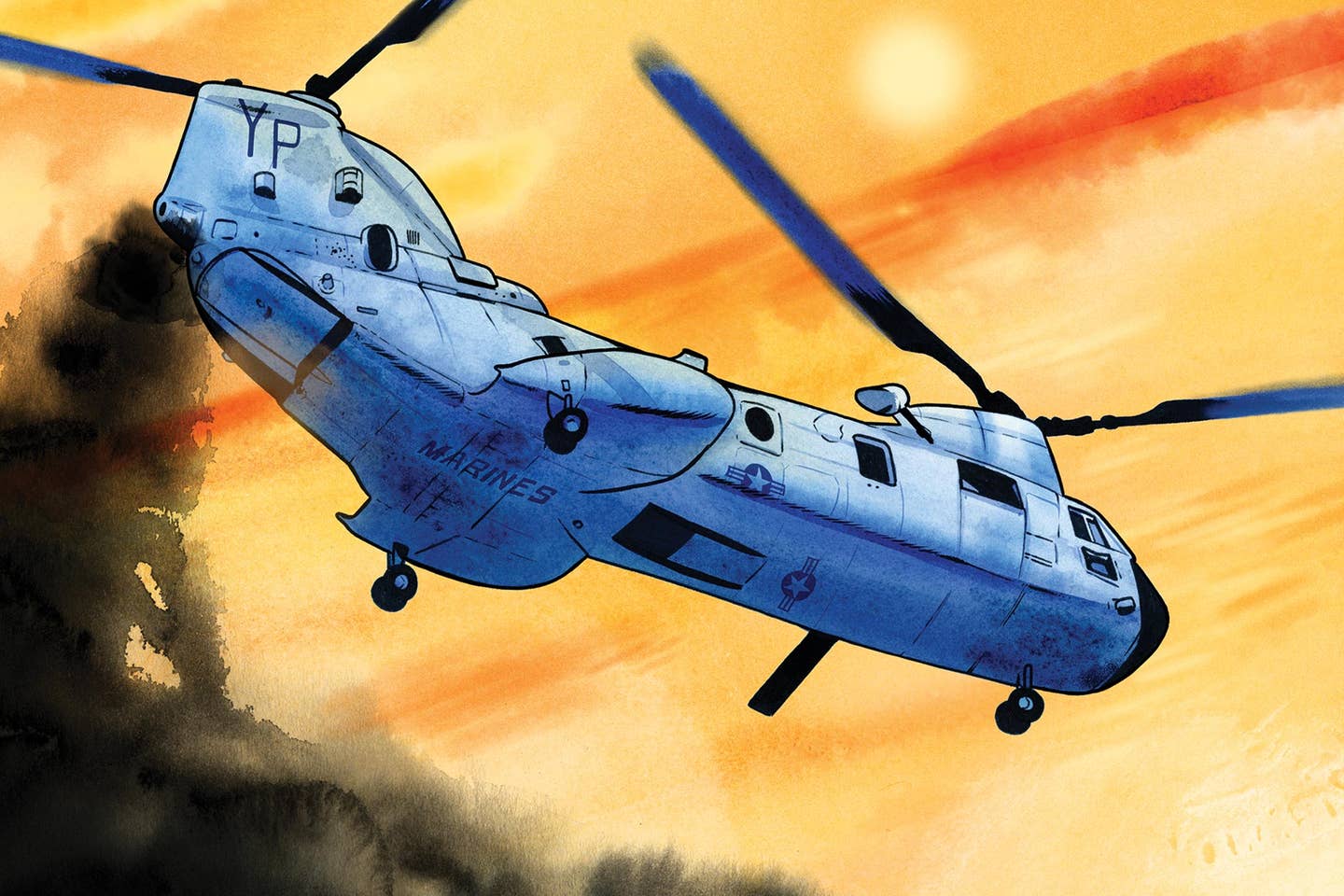
Paul Loschiavo soloed at 16 years old in a Piper Cub, flew helicopters off carriers in the Marine Corps, currently owns and flies a Bristell LSA in South Florida. Joel Kimmel
We’ve all done it—accidentally pressed a wrong button on a computer. It happens. Well, the US Marine Corps CH-46 Sea Knight helicopter has a lot of buttons and switches, and it’s really important to get them right.
Aboard the USS Saipan, off the coast of Sicily, I was on the flight schedule. Easy mission: Fly to Naval Air Station Sigonella, drop off some people and stuff, pick up some people and stuff, and return to the ship. It was complicated a little by the fact that I had to file a flight plan with the Italian air traffic control organization, and I would be flying as dash No. 2 behind a Huey, with the Marine Expeditionary Unit commander as the copilot. Otherwise, a piece of cake for a hotshot pilot.
The flight ashore was pretty uneventful. We made the drop and pickup, and we departed Sigonella. We were at 6,000 feet, and I was talking to Italian ATC. Suddenly, the crew chief comes onto the intercom and shouts: “Sir, we have smoke in the cabin. Get this thing on the ground!”
I immediately initiated an emergency descent, which in a 46 means coming down at about 2,000 fpm. Starting from 6,000 feet, it meant that we would take three minutes to get onto the ground, which is a long time when there’s smoke in the cabin.
I keyed the mic and, knowing I was talking to an Italian controller, slowly and calmly said: “Mayday, mayday, mayday. This is US Marine helicopter Echo Hotel Zero-Two declaring an emergency. We have smoke in the cabin and are going down approximately 6 miles southeast of NAS Sigonella. We have 14 souls on board.”
The Italian controller acknowledged me and notified NAS Sigonella, which scrambled the search and rescue helicopter. My wingman, Huey, which launched a few minutes ahead of us, overheard my mayday and canceled their clearance to try to find us.
The passengers in the back saw the crew chief carrying a fire extinguisher, smelled smoke in the cabin, and felt the aircraft descending like an express elevator in a skyscraper. Eleven sets of underwear would undoubtedly have to be washed later.
On board the ship, the US Navy air traffic controllers overheard my mayday and notified the air boss that one of their helicopters was going down. The air boss notified the captain, who notified the commodore. The commodore ordered the fleet of four ships to turn toward us to assist.
About halfway down, I keyed the intercom and said: “If we’re going to be stuck somewhere, it might as well be someplace nice. I’ve been stuck in the boonies too many times. Hey, look. Two o’clock. A resort right on the beach. I’m thinking veal scallopini piccata with a chilled bottle of pinot grigio for dinner. I hope they have garlic bread. We’ll land in that field next to the resort.” Getting closer, I gave the command, “Start the APU.”
The CH-46 has two large engines that drive the rotors. There is actually a third, smaller jet engine that provides hydraulic and electric power when the main engines are not running. This auxiliary power unit is often called “the ape.” It’s normally used to provide the power to start the main engines and then shut down. It’s also normally started anytime there’s a mechanical problem.
Read More: I Learned About Flying From That
The copilot reached up to start the APU and said, “Sir, the APU is already running.”
Uh-oh.
The APU has a maximum-continuous-use time limit of 30 minutes. It had been running for well over an hour.
“Shut it down.”
Oh, man. We must have left it on after we started the engines. The only way of knowing it’s running is by looking at the on-off switch.
I thought for a second and announced over the intercom: “We must have left the APU running, and I’d bet that’s our problem. OK, listen up. Here’s what we’ll do: Reedy [the crew chief], when we’re on the ground, you get all the passengers off, and then see if you can verify if the smoke is coming from the APU. Charlie [the copilot], we’ll keep the engines running until Reedy tells us what’s happening. I have a feeling that there won’t be any veal scallopini tonight.”
I landed the aircraft about a hundred yards from the fence around the pool at the resort. Just about everyone in the pool got out and came to the fence. Quickly, there were a hundred spectators.
Reedy got all the passengers off and mustered on the side of the aircraft where I could see them. Apparently, none of them had to be told twice to exit the aircraft.
Reedy started poking around the compartment that holds the APU.
“Sir, I can’t be positive, but I’m sure that’s it. I think we burned up the APU,” he said. Oh, joy.
“Reedy, get everyone back on board,” I said. “Tell them to wave nicely and be friendly to our spectators. Let’s try to avoid an international incident.”
We took off and joined up on the Huey, headed for the ship.
Uh-oh. Another problem. Now we’re getting low on fuel. I didn’t plan on a side trip to an Italian resort. The Huey is somewhat slower than a 46, and the 46 gets the best range by going as fast as possible.
“Lead, this is dash two. I’m a little low on fuel. I’m going to have to crank it up and meet you back at the ship.”
I recognized the MEU commander’s voice as the response came: “Go.”
I increased to maximum speed and, once ahead of the Huey, called the ship. “Center, this is Zero-Two, inbound for landing. Fourteen souls on board. Three-zero minutes to splash. Request the deck be ready for immediate recovery.”
“Zero-Two, Center, are you declaring an emergency?”
“Negative. If the deck is ready, we have no problem. We have visual at this time.” (Naval Air Training and Operating Procedures Standardization—the Navy and Marine Corps pilot’s operating handbook—requires that we be on the ground with 20 minutes of fuel remaining because of lack of reliability of fuel gauges.)
“Zero-Two, roger. The deck is ready for immediate recovery. Squadron maintenance requests the nature of your emergency ashore.”
Oh, boy. “Uh…Center…we had a mechanical problem. It’s resolved now.” Announcing to the world that we screwed up just didn’t seem like a great idea. Little did I know.
The landing was uneventful, but when the rotors stopped, the squadron commander climbed into the cockpit. “So, what happened?” he asked
“Sir, we screwed up,” I said. “Left the APU running, and it burned up. Had to do a precautionary landing on Sicily, then we got low on fuel.”
“Well, get up to PriFly as soon as possible. They have to send out an oprep-3.”
“Sir, what’s that?”
“It’s a message to the National Command Authority and the State Department letting them know about an unscheduled event on foreign soil.”
Great. He continued, “And, Paul, next time, use the checklist.”
“Aye-aye, sir.”
He was a good commander. He never mentioned it again.
This story appeared in the September 2020 issue of Flying Magazine

Sign-up for newsletters & special offers!
Get the latest FLYING stories & special offers delivered directly to your inbox






